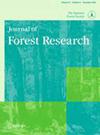Evaluating ground disturbance at elephant skid trails, logging roads and log landings under the Myanmar selection system
IF 1.1
4区 农林科学
Q3 FORESTRY
引用次数: 0
Abstract
ABSTRACT There has been growing interest in the practice of reduced-impact logging (RIL) to enhance various ecological services of selectively logged tropical forests. It is thus important to evaluate the effectiveness of different logging operations between RIL and conventional logging (CON). The Myanmar Selection System (MSS) has a long history and is well known for its use of elephants for skidding, which is considered one form of RIL. However, the difference in the impacts of logging operations between the MSS using elephants for skidding and machine-only-based operations commonly adopted in other countries is unknown. The present study evaluated ground disturbance along elephant skid trails, along logging roads and at log landings in four compartments logged under the MSS, comparing with reported values for CON and RIL in the other countries. The ground disturbance in the MSS compartments was, respectively, 2.1% and 0.4% in average for logging roads and log landings; it is not significantly different from that for CON and RIL (p > 0.05). In contrast, the disturbed area along elephant skid trails (0.9%) is much lower than that for CON (5.2%) and RIL (4.7%) (p < 0.05). A large difference in the width of skid trails was found between elephant skidding (1.0 m) and machinery (CON: 5.5 m, RIL: 4.6 m) (p < 0.0001). We conclude that elephant skidding can largely reduce ground disturbance due to much narrower width of the skid trails as compared with machine skidding, while MSS does not differ from the other countries in ground disturbance at logging roads and log landings.评估缅甸选择制度下大象滑道、伐木路和伐木点的地面干扰
通过减少影响采伐(RIL)来增强选择性采伐热带森林的各种生态服务,已引起人们越来越多的兴趣。因此,评估RIL和常规测井(CON)之间不同测井作业的有效性非常重要。缅甸选拔制度(MSS)历史悠久,以使用大象进行滑行而闻名,这被认为是RIL的一种形式。然而,MSS使用大象进行打滑的伐木作业与其他国家通常采用的仅基于机器的伐木作业之间的影响差异尚不清楚。本研究评估了在MSS下记录的四个隔间中沿着大象滑道、伐木道路和伐木着陆处的地面干扰,并与其他国家CON和RIL的报告值进行了比较。采伐道路和采伐平台的地面扰动平均分别为2.1%和0.4%;与CON、RIL比较,差异无统计学意义(p < 0.05)。大象滑道沿线的干扰面积(0.9%)远低于CON(5.2%)和RIL (4.7%) (p < 0.05)。大象打滑(1.0 m)和机械打滑(CON: 5.5 m, RIL: 4.6 m)之间的打滑痕迹宽度差异很大(p < 0.0001)。我们得出的结论是,与机器打滑相比,大象打滑可以大大减少地面干扰,因为打滑痕迹的宽度要窄得多,而MSS在伐木道路和伐木降落点的地面干扰方面与其他国家没有什么不同。
本文章由计算机程序翻译,如有差异,请以英文原文为准。
求助全文
约1分钟内获得全文
求助全文
来源期刊

Journal of Forest Research
农林科学-林学
CiteScore
3.00
自引率
6.70%
发文量
62
审稿时长
3 months
期刊介绍:
Journal of Forest Research publishes original articles, reviews, and short communications. It covers all aspects of forest research, both basic and applied, with the aim of encouraging international communication between scientists in different fields who share a common interest in forest science.
 求助内容:
求助内容: 应助结果提醒方式:
应助结果提醒方式:


